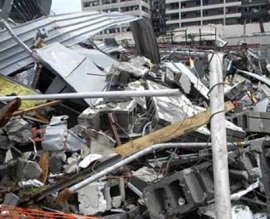
by Brianna Crandall — May 11, 2015—The U.S. Department of Commerce’s National Institute of Standards and Technology (NIST) issued a draft guide on April 27 to help communities plan for and act to keep windstorms, floods, earthquakes, sea-level rise, industrial mishaps and other hazards from inflicting disastrous consequences. NIST says the guide is expected to help communities not only “weather the storm” but also to bounce back quickly and efficiently after a hazard passes.
The Community Resilience Planning Guide for Buildings and Infrastructure provides an integrated perspective on improving the resilience of buildings and infrastructure systems in the context of sustaining community functions such as health care, education and other important local services. It is designed to help communities develop and implement plans that will help to prevent and reduce devastation from natural and human-caused hazards and prolonged recoveries in their aftermath.
Acting NIST Director Willie May reminds that when disaster strikes, communities often suffer devastating losses of people and property, and that recovery can take months to years and cost billions of dollars. Over the last four years, the nation experienced 42 extreme weather events that caused at least $1 billion in damage, costing about $227 billion and killing 1,286 people. In all, there were 334 major disaster declarations in the USA between 2010 and 2014.
But these tremendous losses are not inevitable, says May. There is much we can do to make our communities more resilient, that is, better able to adapt to changing climate conditions, withstand hazards, and recover efficiently in their aftermath.
The guide lays out a six-step process that starts with the formation of a resilience team drawn from the community and culminates with the development and implementation of resilience strategies that are updated regularly. The resilience team’s role is to engage community representatives in a series of efforts that include defining how vital social functions like healthcare, education and public safety are supported by local buildings and infrastructure systems, such as power, water and transportation.
The guide is an important addition to the National Preparedness System, which provides a way to organize preparedness activities and programs. Nearly 24,000 U.S. communities have developed mitigation plans that aim to reduce the risk of damage from a hazard, according to the Federal Emergency Management Agency (FEMA). Effective mitigation measures will, for example, protect a building from flooding, but factoring in resilience will help to ensure that the structure also has power and water during recovery.
The draft guide consists of two volumes. The first volume provides an overview of community resilience and summarizes the six steps involved in developing and implementing a resilience plan. It also provides an example of how a fictional community uses the framework to plan and guide resilience efforts.
The second volume serves as a detailed resource to support the six steps. It includes comprehensive sections on characterization of social and economic functions, buildings, transportation, energy, communication, water and wastewater and community resilience metrics.
The draft planning guide was developed by NIST researchers and outside experts in disciplines ranging from buildings to public utilities, and from earthquake engineering to sociology, with extensive input from stakeholders. The official first version of the guide will be released this fall and updated periodically. NIST is requesting public feedback on the draft guide for 60 days.




